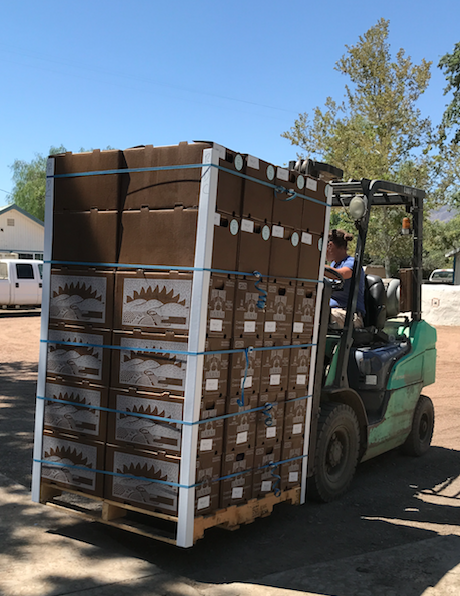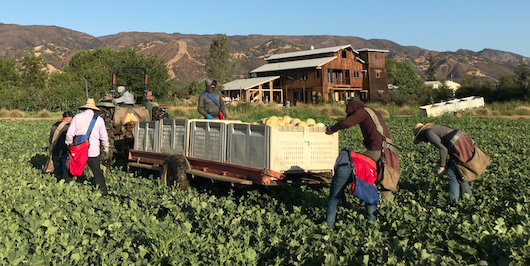The news from the farm from the past week is: eggplants and melons. And more eggplant and more melons. While our tomatoes are growing frustratingly slowly (we hope to have them in the boxes soon) these two crops are thriving right now and thus are worth diving into, accompanied by some photos of our crew at work.

Eggplant:
How do you harvest eggplants? With clippers, and ideally with long sleeves and gloves too since they can have thorns. Each picker has a 5-gallon bucket that they fill up and empty into the macro bins on the back of the tractor, separated by type. Right now, the eggplant plants are small enough for our tall harvest tractor to drive over them, but soon enough, they’ll be too tall to fit under, eventually growing up to four feet. Soon, the tractor will move over to one of the rows of basil we intercrop between every few eggplant rows. The rows of basil leave plenty of clearance for the tractor and attract pollinators because we leave sections to go to flower.


When the bins on the tractor are full, the tractor heads back to the shop where the eggplant are sorted, washed (and the water also serves to cool them down) and then packed for orders or CSA boxes.
This year, an additional reason to pay attention to our eggplants (in addition to their beautiful flowers and tasty fruit) is that these fields are part of an experiment looking at no-till farming and how it impacts soil health and plant yields. Tillage is how you prepare the soil for planting and control for weeds and no-till, or low-till, fields disturb the soil less, which is better for soil health. It’s long been used in the midwest for commodity corn and soy, but with the aid of herbicides, and the research for no-till in commercial organic production is lacking. We’re part of a group of organic farms trialing no-till farming methods. No-till farming could be the subject of this week, and every week’s, News from the Farm but since we need to talk about melons too, those who are interested in learning more about the research group and the background science can catch up with this piece from Civil Eats, this short update from CalCAN, or even watch the webinar that Paul participated in this year that the CalCAN blog references.


No Till With Plastic Mulch
The result is that we’ve got eggplant rows with and without tillage and without plastic mulch (for weed control, water conservation, and early season soil insulation) and all possible combinations. The jury is still out, but we’re very interested to see how the plants do. As of right now, they all seem to be doing great.

Boxes eggplant ready to be delivered
Melons:
We grow many different melons. We plant a lot of some varieties, and much less of others. Some ripen all at once, some are staggered. Some are slip melons (the stem separates from the melon when ripe) while others aren’t. Some need to be refrigerated once harvested while others don’t need to.

The few things that are consistent is that we harvest them ripe and while we’ve got some staples and clear favorites, we’re always willing to experiment with a few new varieties.

Like the eggplants, a tractor goes through the field pulling a trailer of large bins. The harvest crews pick up melons, add them to their harvest bags, and then when full, empty them into the bins. Except for watermelon, which are too heavy for the bags and go straight into the bin. Depending on the type of melon, we may only go over a row once, or we may visit it a few times to catch them all. After harvest, the melons head over to the shop where they’ll go through the washer, get sorted and then they too get boxed up and sent to their new homes.

Enjoy these two tasty summer fruits!
Elaine Swiedler, CSA Manager
